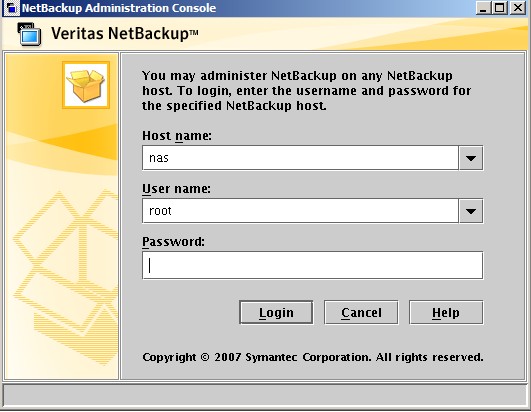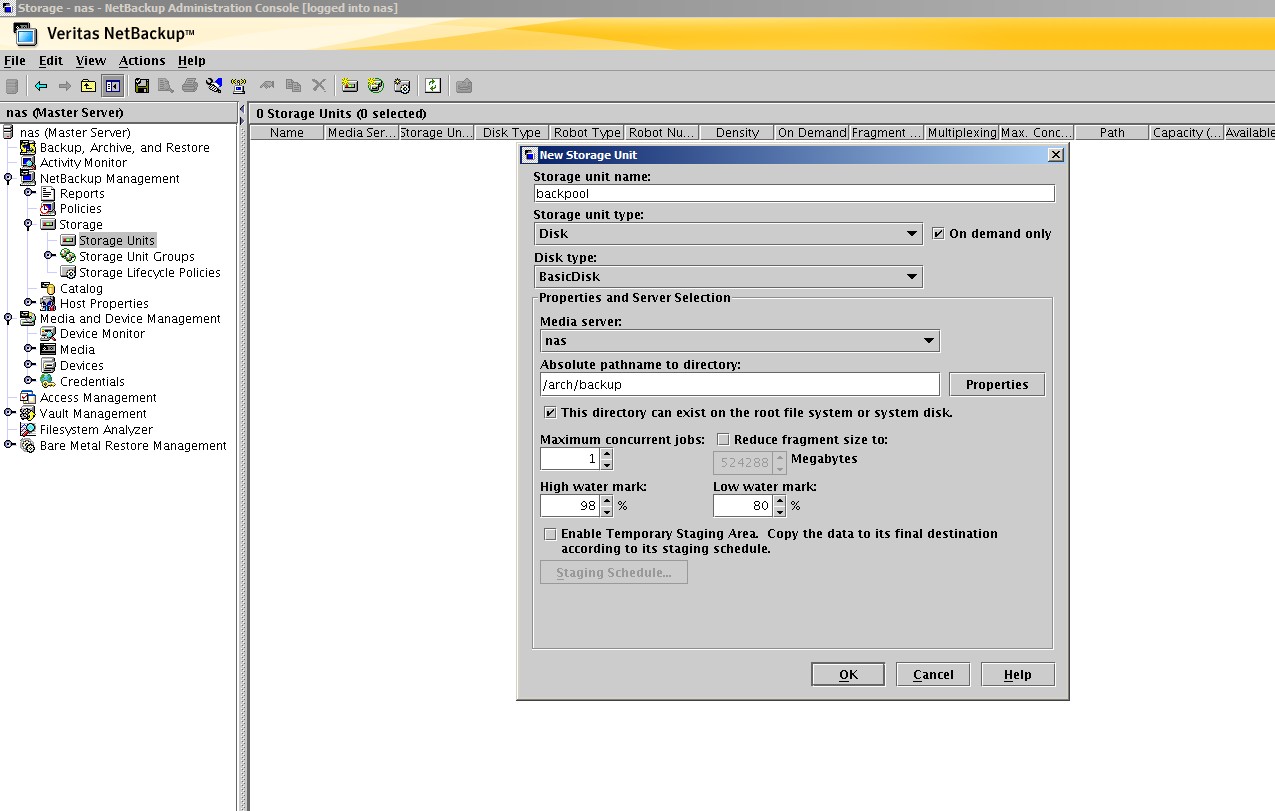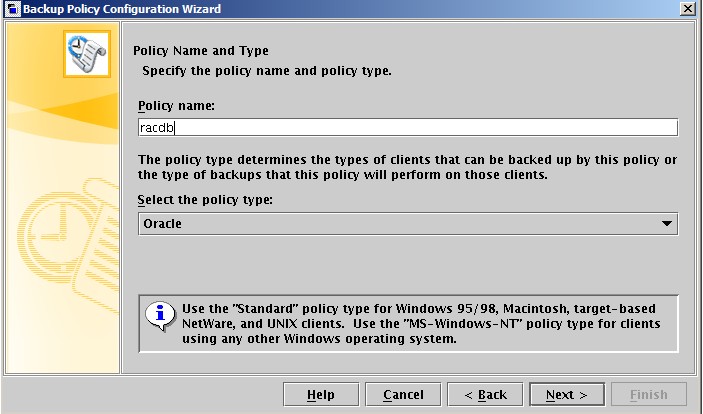我们使用Linux平台进行测试,OS版本为Oracle Enterprise Linux 5.5 x86_64:
[root@nas servsoft]# cat /etc/issue
Enterprise Linux Enterprise Linux Server release 5.5 (Carthage)
Kernel \r on an \m
Netbackup 6.0仅支持2.4内核的Linux版本,2.6内核的Linux版本(主流的包括RHEL4,5 Centos等)需要使用NBU,只能安装Netbackup 6.5或以上版本。
现在我们有三台主机: rh1(rac的2号节点),rh2(rac的1号节点),nas(NBU Server)。
首先需要安装的是Netbackup Server端软件,当然你需要用到安装介质,你可以尝试在Veritas的官方网站下载到最新的版本;获取到安装介质后,我们首先要解压它:
[root@nas netbackup]# cp NetBackup_6.5_LinuxRedhat2.6.tar.gz /tmp
[root@nas tmp]# gunzip NetBackup_6.5_LinuxRedhat2.6.tar.gz
[root@nas tmp]# tar -xvf NetBackup_6.5_LinuxRedhat2.6.tar
在进入安装前确认xinetd服务正确运行着:
[root@nas tmp]# service xinetd status
xinetd (pid 2886) is running...
[root@nas NB_65_LinuxR_x86_20070723]# ./install
Do you want to install NetBackup and Media Manager files? [y,n] (y) y
NetBackup and Media Manager are normally installed in /usr/openv.
Is it OK to install in /usr/openv? [y,n] (y) y
Reading NetBackup files from /tmp/NB_65_LinuxR_x86_20070723/linuxR_x86/anb
...................
Enter the full path name to the directory where the
appropriate installics script is located followed by
a to continue. This script will then install
the package(s).
OR
Enter q to stop this install and abort.
此时我们需要输入Netbackup ISC(Infrastructure Core Services)软件所在的目录,当然你也可以从Veritas官方网站下载到该软件包,尝试解压:
[root@nas tmp]# cp NetBackup_6.5_ICS_LinuxX86.tar.gz /tmp
[root@nas tmp]# cd /tmp
[root@nas tmp]# gunzip NetBackup_6.5_ICS_LinuxX86.tar.gz
[root@nas tmp]# tar -xvf NetBackup_6.5_ICS_LinuxX86.tar
则此时ISC安装介质位于/tmp/NB_65_ICS_1.4.37.0_LinuxX86下,在原终端窗口中输入该目录
Enter q to stop this install and abort.
/tmp/NB_65_ICS_1.4.37.0_LinuxX86
Installing VRTSpbx...
A NetBackup Server or Enterprise Server license key is needed
for installation to continue.
Enter license key:
继续安装,此时需要输入您所购买的License注册码;如果您没有购买该软件但仍想使用的话,
可以尝试下面一串字符:DEX6-23FJ-T92R-O4O4-O4O4-K777-7777-EPXP-3XO。
Enter license key: DEX6-23FJ-T92R-O4O4-O4O4-K777-7777-EPXP-3XO
DEX6-23FJ-T92R-O4O4-O4O4-K777-7777-EPXP-3XO:
NetBackup Enterprise Server Base product with all the features enabled
has been registered.
All additional keys should be added at this time.
Do you want to add additional license keys now? [y,n] (y) n
Use /usr/openv/netbackup/bin/admincmd/get_license_key
to add, delete or list license keys at a later time.
Installing NetBackup Enterprise Server version: 6.5
If this machine will be using a different network interface than the
default (nas), the name of the preferred interface should be used
as the configured server name. If this machine will be part of a
cluster, the virtual name should be used as the configured server name.
Would you like to use "nas" as the configured
name of the NetBackup server? [y,n] (y) y
Is nas the master server? [y,n] (y) y
Do you have any media servers? [y,n] (n) n
Checking /etc/services for the needed NetBackup and Media Manager services.
Copying original /etc/services file to /etc/services.NBU_062910.14:27:41
Editing /etc/services to update NetBackup and Media Manager services.
/etc/services will be updated to add the following entries for
NetBackup/Media Manager.
bpjobd 13723/tcp bpjobd
vmd 13701/tcp vmd
acsd 13702/tcp acsd
tl8cd 13705/tcp tl8cd
tldcd 13711/tcp tldcd
odld 13706/tcp odld
tl4d 13713/tcp tl4d
tshd 13715/tcp tshd
tlmd 13716/tcp tlmd
tlhcd 13717/tcp tlhcd
rsmd 13719/tcp rsmd
...................
好了Netbackup Server端软件已经在NAS主机上安装完成,接下来我们需要进一步配置备份策略。
将/usr/openv/netbackup/bin路径加入到你的用户环境变量PATH中,以方便调用相关执行文件;
并在具有X11 forwarding功能的软件中(譬如Xmanager)中输入jnbSA命令,
您可能遭遇java.lang.UnsatisfiedLinkError: /usr/openv/java/jre/lib/i386/libawt.so: libXp.so的错误,
一般是由于没有安装libXp(i386和x86_64版本的都装一下)包所导致的。
正确安装的话输入jnbSA命令可以看到以下界面:
接着我们需要定义存储单元(Storage Unit),如果你同我一样没有真实的磁带机的话那么我们可以定义普通Disk
类型的存储单元, 选择Netbackup Management->Storage -> Storage Unit,在右边分隔栏右键点击New Storage Unit,
为你的存储单元起一个名字,并输入相关存储目录:
接下来点击NetBackup Management->Policies 选项定义Oracle备份使用到的备份策略,启用Backup Policy Configuration Wizard,并选择Oracle为备份策略类型:
在客户端列表(client list)中加入需要备份2台RAC所在主机,分别为rh1,rh2;硬件与操作系统选择Linux,Redhat2.6
好了,server端的配置完成了,接下来我们安装client端软件,安装前确认你已经获得了相关安装介质,以NBU6.5举例来说你需要有:NetBackup_6.5_CLIENTS2.tar.gz和NetBackup_6.5_UnixOptions.tar.gz 分别为Client端和Oracle Agent软件。
[root@rh2 tmp]# gunzip NetBackup_6.5_UnixOptions.tar.gz [root@rh2 tmp]# gunzip NetBackup_6.5_CLIENTS2.tar.gz [root@rh2 tmp]# tar -xvf NetBackup_6.5_UnixOptions.tar [root@rh2 tmp]# tar -xvf NetBackup_6.5_CLIENTS2.tar [root@rh2 tmp]# cd NB_65_CLIENTS2_20070723/ [root@rh2 NB_65_CLIENTS2_20070723]# ./install Symantec Installation Script Copyright 1993 - 2007 Symantec Corporation, All Rights Reserved. Installing NetBackup Client Software NOTE: To install NetBackup Server software, insert the appropriate NetBackup Server cdrom. Do you wish to continue? [y,n] (y) y Do you want to install the NetBackup client software for this client? [y,n] (y) y This package will install Linux/RedHat2.6 client. This package will install NetBackup client 6.5. Enter the name of the NetBackup server : nas Would you like to use "rh2" as the configured name of the NetBackup client? [y,n] (y) y ........................ File /usr/openv/tmp/install_trace.10994 contains a trace of this install. That file can be deleted after you are sure the install was successful. [root@rh2 tmp]# cd NB_65_UOptions_20070723/ root@rh2 NB_65_UOptions_20070723]# ./install Symantec Installation Script Copyright 1993 - 2007 Symantec Corporation, All Rights Reserved. Installation Options 1 NetBackup Add-On Product Software 2 NetBackup Database Agent Software q To quit from this script Choose an option [default: q]: 2 ********** There are two ways to install database agent software. 1. Remote Installation: Loads the software on a server with the intent of pushing database software out to affected clients. 2. Local Installation: Loads and installs the software only to this local machine. ********** Do you want to do a local installation? [y,n] (n) y ********** NetBackup Database Agent Installation Choose the Database Agents you wish to install one at a time or select Install All Database Agents. 1) NetBackup for DB2 2) NetBackup for Informix 3) NetBackup for Lotus Notes 4) NetBackup for Oracle 5) NetBackup for SAP 6) NetBackup for Sybase 7) Install All Database Agents q) Done Selecting Agents x) Exit from this Script Choose an option: 4 Choose an option: q You have chosen to install these Database Agents: NetBackup for Oracle Is this list correct? [y,n] (y) y ********** Of the agents selected, the following are supported on this platform and will be installed: Oracle Loading the Database Agent packages into the /usr/openv/netbackup/dbext directory and installing. ********** Installing NetBackup for Oracle Installing NetBackup for Oracle... .......................... NetBackup for Oracle installation completed. 完成NBU客户端和Netbackup for Oracle Agent安装后,我们还需要对MML介质库文件进行链接,使用dba或oinstall组账户执行/usr/openv/netbackup/bin/oracle_link文件: [root@rh2 NB_65_UOptions_20070723]# su - maclean [maclean@rh2 ~]$ cd /usr/openv/netbackup/bin/ [maclean@rh2 bin]$ ./oracle_link Tue Jun 29 19:22:28 EDT 2010 All Oracle instances should be shutdown before running this script. Please log into the Unix system as the Oracle owner for running this script Do you want to continue? (y/n) [n] [maclean@rh2 bin]$ echo $ORACLE_HOME /s01/rac10g [maclean@rh2 bin]$ ./oracle_link Tue Jun 29 19:22:35 EDT 2010 All Oracle instances should be shutdown before running this script. Please log into the Unix system as the Oracle owner for running this script Do you want to continue? (y/n) [n] y LIBOBK path: /usr/openv/netbackup/bin ORACLE_HOME: /s01/rac10g Oracle version: 10.2.0.5.0 Platform type: x86_64 Linking LIBOBK: ln -s /usr/openv/netbackup/bin/libobk.so64 /s01/rac10g/lib/libobk.so Done
接下来在rh2主机上进行备份测试:
[maclean@rh2 bin]$ rman target /
Recovery Manager: Release 10.2.0.5.0 - Production on Tue Jun 29 19:26:00 2010
Copyright (c) 1982, 2007, Oracle. All rights reserved.
connected to target database: RACDB (DBID=720516428)
RMAN> run
2> { allocate channel c1 type sbt parms="ENV=(NB_ORA_SERV=nas,NB_ORA_POLICY=racdb,NB_ORA_CLIENT=rh2)";
3> backup current controlfile;
4> release channel c1;
5> }
RMAN> run
2> { allocate channel c1 type sbt parms="ENV=(NB_ORA_SERV=nas,NB_ORA_POLICY=racdb,NB_ORA_CLIENT=rh2)";
3> backup current controlfile;
4> release channel c1;
5> }
using target database control file instead of recovery catalog
allocated channel: c1
channel c1: sid=136 instance=racdb1 devtype=SBT_TAPE
channel c1: Veritas NetBackup for Oracle - Release 6.5 (2007072323)
Starting backup at 29-JUN-10
channel c1: starting full datafile backupset
channel c1: specifying datafile(s) in backupset
including current control file in backupset
channel c1: starting piece 1 at 29-JUN-10
channel c1: finished piece 1 at 29-JUN-10
piece handle=03lhfi11_1_1 tag=TAG20100629T192729 comment=API Version 2.0,MMS Version 5.0.0.0
channel c1: backup set complete, elapsed time: 00:00:37
Finished backup at 29-JUN-10
released channel: c1
如上所示成功备份了当前控制文件。
RMAN> run
2> {
3> allocate channel c1 type sbt parms="ENV=(NB_ORA_SERV=nas,NB_ORA_POLICY=racdb)";
4> backup archivelog all delete input;
5> release channel c1;
6> }
using target database control file instead of recovery catalog
allocated channel: c1
channel c1: sid=136 instance=racdb1 devtype=SBT_TAPE
channel c1: Veritas NetBackup for Oracle - Release 6.5 (2007072323)
Starting backup at 29-JUN-10
channel c1: starting archive log backupset
channel c1: specifying archive log(s) in backup set
input archive log thread=1 sequence=1 recid=2 stamp=722901460
input archive log thread=1 sequence=2 recid=4 stamp=722901476
input archive log thread=1 sequence=3 recid=5 stamp=722901499
input archive log thread=1 sequence=4 recid=6 stamp=722904852
input archive log thread=2 sequence=1 recid=1 stamp=722901426
input archive log thread=2 sequence=2 recid=3 stamp=722901470
input archive log thread=2 sequence=3 recid=7 stamp=722904852
channel c1: starting piece 1 at 29-JUN-10
channel c1: finished piece 1 at 29-JUN-10
piece handle=06lhfjqr_1_1 tag=TAG20100629T195819 comment=API Version 2.0,MMS Version 5.0.0.0
channel c1: backup set complete, elapsed time: 00:00:46
channel c1: deleting archive log(s)
archive log filename=/arch/1_1_722899663.dbf recid=2 stamp=722901460
archive log filename=/arch/1_2_722899663.dbf recid=4 stamp=722901476
archive log filename=/arch/1_3_722899663.dbf recid=5 stamp=722901499
archive log filename=/arch/1_4_722899663.dbf recid=6 stamp=722904852
archive log filename=/arch/2_1_722899663.dbf recid=1 stamp=722901426
archive log filename=/arch/2_2_722899663.dbf recid=3 stamp=722901470
archive log filename=/arch/2_3_722899663.dbf recid=7 stamp=722904852
Finished backup at 29-JUN-10
Starting Control File and SPFILE Autobackup at 29-JUN-10
piece handle=c-720516428-20100629-01 comment=API Version 2.0,MMS Version 5.0.0.0
Finished Control File and SPFILE Autobackup at 29-JUN-10
released channel: c1




Leave a Reply to admin Cancel reply